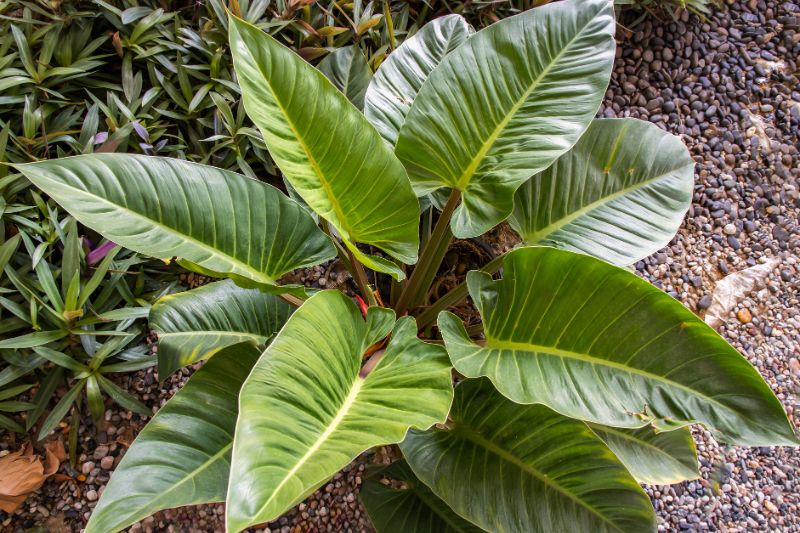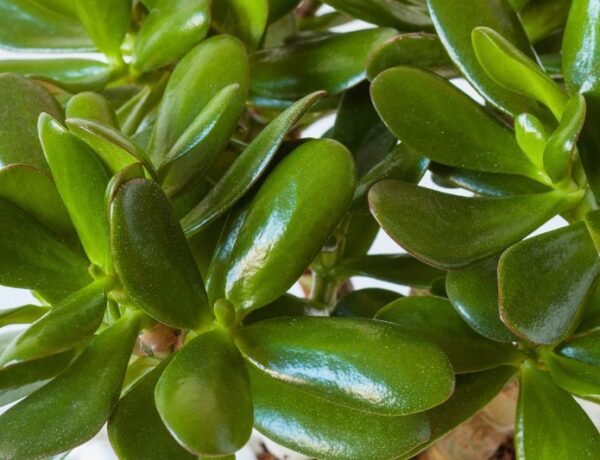Bringing the captivating charm of the tropical rainforests right into your living room, Philodendron Melinonii is a spectacular choice for indoor plant enthusiasts. This care guide will give you the knowledge you need to help your Melinonii thrive and become a standout in your indoor jungle.
Table of Contents
1. General Information & Taxonomy
| Scientific name: | Philodendron melinonii Brongn. ex Regel |
| Common names: | Melinon’s Philodendron |
| Native to: | Central and South America |
| Toxicity: | Toxic to pets (cats and dogs) |
| Mature size: | Leaves can grow up to 28 inches long and 20 inches wide. The entire plant can span up to 8 feet across. |
| Category: | Epiphytic and terrestrial plant |
| Growth Rate: | Moderate to fast, depends heavily on the amount of light received. |
| Hardiness: | USDA Hardiness Zones 9b to 11 |

2. Philodendron Melinonii Care & Growing Requirements
» Watering
For a healthy Philodendron melinonii, water the plant when the top few inches of soil have dried out. Overwatering can lead to root rot, which can be difficult to reverse.
You can test if it’s the time for watering by inserting your finger into the soil up to your first or second knuckle. If it’s dry, then that’s your cue!
» Light
Philodendron Melinonii needs bright indirect light. It can handle more direct sunlight than other Philodendron varieties, especially morning sunlight.
The afternoon sun? Not so much. A little bit is fine, but remember: everything in moderation.
» Soil
This philodendron prefers a well-draining potting mix with good aeration. A combination of bark, potting soil, peat or coco coir, perlite, and worm castings should do the trick. You can also grow it in a soilless medium like sphagnum moss, perlite or vermiculite.
And if that’s too much of a hassle, you can use a comercial potting mix designed for aroids.
» Temperature
Ideal temperatures for the Philodendron melinonii should stay between 60°F and 85°F. Temperatures below 55°F can be harmful to the plant.
» Humidity
As a tropical plant, the Melinonii prefers high humidity, ideally above 50%. A small humidifier can be used if the humidity drops too low.
» Fertilizer
Fertilize your plant monthly during the spring and summer months, using an organic liquid fertilizer.
3. Philodendron Melinonii Maintenance and Propagation
» Repotting
Repotting is an essential part of Philodendron melinonii care, ensuring it has enough room to grow and fresh soil to thrive in. This plant needs a pot with good drainage, as stagnant water can lead to root rot, a common issue for many indoor plants.
Ideally, repot your Melinonii every 2-3 years. The best time to do this is in early spring before the onset of the growing season. Gently remove the plant from its current pot, prune any dead or decaying roots, and place it into a new pot that is a couple of inches larger in diameter.
Use the well draining soil mix for the best results.
» Pruning
Pruning is essential not only for maintaining the size and shape of your Philodendron Melinonii but also for its overall health. Regular trimming can help to keep the plant looking lush and full, and also allows for the removal of dead or dying foliage that could potentially drain energy from the plant.
Use a clean, sharp pair of pruning shears and make your cuts close to the main stem to maintain a natural appearance. In terms of frequency, light pruning can be done at any time of the year, but for a more substantial prune, it’s best to do this in the late winter or early spring, before new growth begins.
» Propagation
Philodendron melinonii can be propagated through the pups that the parent plant produces. These small offsets grow from the base of the plant and can be separated to create a new plant.
To do this, dig down into the soil medium and cut away the pups from the parent plant, ensuring they have roots to survive once separated. After cutting, place them in fresh soil. Bright indirect light and a warm environment can stimulate the new plant’s growth.
» Cleaning
Philodendron Melinonii, with its large leaves, can accumulate dust over time. Cleaning the leaves not only makes the plant look better, but it also helps the plant photosynthesize more efficiently. Use a soft, damp cloth to gently wipe the top and underside of each leaf.
A light mist of water can also be used to dampen the cloth. Avoid using any harsh chemicals or cleaning products, as these can damage the leaves.
4. Varieties of Philodendron Melinonii
There are several varieties of the Philodendron melinonii, each with its unique traits. Some notable varieties include the Philodendron Golden Melinonii and ‘Ghost.’
The Golden variety features neon, waxy leaves, while the ‘Ghost’ has a lighter, almost silvery hue to its new leaves, which turning to solid green as they mature. Both varieties are quite rare and also expensive.
5. Common issues
- Leaves Turning Yellow or Brown: If you notice your Melinonii’s leaves turning yellow or brown, it’s often due to overwatering or underwatering. Improper light can also be a factor.
- Leggy Stems: Usually a sign that your plant isn’t getting enough light. Adjust its location for optimal growth.
- Slow Growth: Can be an indicator of low light or insufficient nutrients. Make sure to provide bright indirect light and regular feedings.
6. Philodendron Melinonii Diseases & Pests
Like many indoor plants, the Melinonii can be susceptible to pests such as mealybugs, scale, and spider mites. Regular inspection can help catch these issues early, and treatment typically involves using a mild insecticide or neem oil. Diseases like root rot can occur due to overwatering.
Conclusion
The Philodendron Melinonii, with its strikingly large leaves and resilient nature, makes a remarkable addition to any plant collection.
This tropical beauty thrives with proper care and attention to its specific needs, from its light requirements to the appropriate soil mix.
Providing this care can yield a spectacularly vibrant and healthy plant, ready to bring a piece of the rainforest into your home.






No Comments